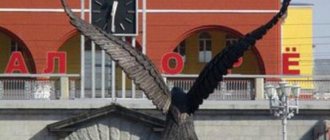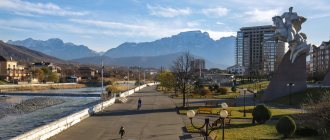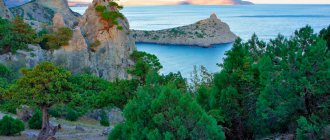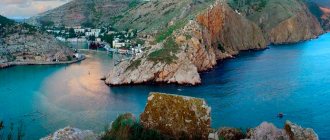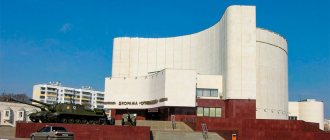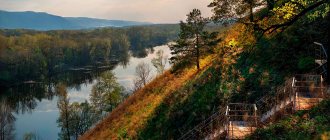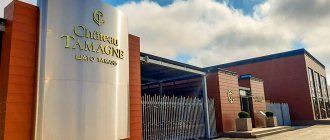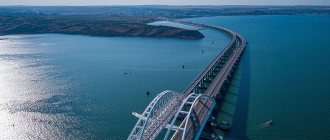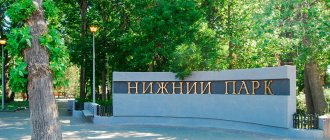Orel stands on the banks of the Oka River and the Orlik tributary flowing into it, the name of which formed the basis for the name of this settlement.
There is another version of the etymology of the city's name. According to legend, during the construction of the fortress, which Tsar Ivan IV the Terrible ordered to be built in 1566, servants cut down an oak tree, and an eagle flew from its branches.
The year the fortress was built is considered the official founding date of Orel. The city became a defensive point against attacks by the Crimean Tatars and other southern nomadic peoples.
Orel was awarded the title of city of military glory, as its inhabitants fought a partisan fight against the German invaders during the almost two-year occupation from October 1941 to August 1943. The city was liberated during Operation Kutuzov during the Battle of Kursk, and it was one of the first victories of Soviet troops over the Germans.
Today the city is associated with the names of famous literary figures: Leskov, Turgenev, Bunin, Andreev.
Historical sites and museums
Shopping arcades
Address: Gostinaya street, building 2
Shop premises built in the 19th – early 20th centuries were erected on the site of shops that were repeatedly burned. The first Gostiny Dvor was built here in the 16th–17th centuries. It simply consisted of huts in which food was sold.
In the 17th century, a wooden hut was built; it included a customs house, a bathhouse, a guest house, and a tavern (Kruzhechny Dvor). After another fire, a stone building with a gallery was erected. There was a wide variety of shops here: Glass, Saddlery, Iron, Dairy.
After the last fire, the shopping arcades were rebuilt in the 19th – early 20th centuries at the expense of merchants and became the shopping center of the city. Such eminent representatives of trade as the Kalashnikovs, Rusanovs, Domogatskys, Bukhvostovs and others presented their goods to customers in numerous shops here.
After the destruction of the Great Patriotic War, the shopping arcades were again restored, and the third floor was added to the building. Now it houses the regional museum of local lore and the central city library named after. A.S. Pushkin. Other premises are occupied by shops, various institutions and organizations.
Oryol Museum of Local Lore
Address: st. Living room, 2. Phone: 8 (4862) 47‑13-91, 8 (4862) 47‑11-93 Website: https://okmuseum.ru Opening hours: Tue-Wed 10:00-18:00; Thu 10:00-21:00; Fri 10:00-18:00; Sat-Sun 10:00-17:00 Cost: from 35 to 70 rubles
The museum was founded in 1897 and is now located in the building of the former Trading Rows. There are exhibitions here that reflect the history, culture and life of the inhabitants of this area for many centuries. It also contains information about representatives of the animal and plant world of the Oryol region.
In the halls of the local history museum you can look at:
- household items and furnishings of a typical home of Oryol merchants;
- a collection of porcelain dishes and carved furniture brought from the princely estate of the Kurakin family;
- costumes of peasants and wealthy townspeople of the 19th-20th centuries;
- archival documents and portraits of prominent personalities of that era.
There are also photographs of people who glorified the city and the region as a whole with their activities, as well as exhibits dedicated to wartime.
House-Museum of V. A. Rusanov
Address: : st. Rusanova, 43. Telephone: Website: https://okmuseum.ru Opening hours: Wed-Sun 10:00-17:00 Cost: from 35 to 70 rubles
The museum is dedicated to the life and research activities of Vladimir Aleksandrovich Rusanov, a famous Soviet geologist and ethnographer who completed five polar expeditions.
His image became the prototype of the main character of the novel by writer Veniamin Kaverin “Two Captains”, Alexander Grigoriev.
Rusanov was the first to reach the Barents Sea as a result of studying Novaya Zemlya, compiled maps of the archipelago and discovered several previously unknown species of fossil animals.
In the halls of the museum, which is located in a house built in the 19th century, where the scientist spent his childhood and youth, extensive ethnographic material is presented, telling about the life and customs of the northern peoples inhabiting Novaya Zemlya.
House-Museum of N. S. Leskov
Address: : st. Oktyabrskaya, 9. Phone: 8 (4862) 76‑33-04, 8 (4862) 76‑15-00 Website: https://turgenevmus.ru/dom-muzej-ns-leskova Opening hours: Mon-Thu , Sat-Sun 10:00-17:00, Friday - closed Cost: from 50 to 200 rubles
Dedicated to the life and work of the writer Nikolai Semenovich Leskov. The museum building was built in 1894 on the site where the family estate of the Leskov family previously stood. This mansion was designed by the architect Franz Iosifovich Thibault-Brignol.
This room contains the writer’s personal belongings received from his relatives and descendants. Here hangs a copy of a portrait created by the artist Valentin Serov.
Visitors can look at the collections of rare books and minerals collected by Nikolai Semenovich himself, his gallery, library and study. This room was recreated from photographs of his creative workshop in St. Petersburg, in a house on Furshtatskaya Street (where Leskov lived for several years before his death).
The museum organizes “Leskov Readings” every year in mid-March.
There is also a home theater, whose actors perform excerpts from productions created by Leskov for visitors.
Bunin Museum
Address: : per. Georgievsky, 1. Phone: 8 (4862) 76‑33-04, 8 (4862) 76‑15-00 Website: https://turgenevmus.ru/muzej-ia-bunina Opening hours: Mon-Thu, Sat -Sun 10:00-17:00, Friday - closed Cost: from 50 to 200 rubles
The museum building was chosen in the historical district of the city, which Ivan Bunin often visited while he lived for three years in Orel and worked as a journalist for the local publication Orlovsky Vestnik. It is impossible to establish the exact place of residence of the writer at that time, since he changed apartments very often.
The museum accurately reproduces the writer's office, which was built in a Parisian apartment after emigrating to France. All furniture, writing instruments, books and interior details were brought from there and are originals.
There are many archival documents presented here, including photographs of the writer himself and members of his family, copies of editions of Bunin’s works and the writer’s personal belongings such as his smoking pipe, briefcase, etc.
In the museum you can listen to a tape recording of the writer reading his own poem “Loneliness.”
Turgenev Museum
Address: st. Turgeneva, 11. Phone: 8 (4862) 76‑33-04, 8 (4862) 76‑15-00 Website: https://turgenevmus.ru Opening hours: Mon-Thu, Sat-Sun 10:00- 17:00, Friday - closed Cost: from 50 to 200 rubles
This institution was opened by the specially created Turgenev Society in 1918.
For almost fifty years, the museum’s collection has been systematically replenished with household items belonging to Ivan Sergeevich Turgenev himself and his relatives, family portraits, photographs, archival editions of books both from the writer’s personal library and novels under his authorship, as well as handwritten versions of works, created by Turgenev himself.
Most of the exhibits that were previously located here were transferred in 1976 to the newly restored Turgenev family estate, Spasskoye-Lutovinovo.
Oryol Military History Museum
Address: st. Normandy-Neman, 1. Phone: 8 (4862) 59‑06-45 Website: https://okmuseum.ru/vim Opening hours: Tue-Wed 9:00-18:00; Thu 12:00-18:00; Fri-Sun 9:00-18:00 Cost: from 35 to 70 rubles
The museum is located in the former mansion of the Oryol merchant Chikin. The building is one of the architectural monuments.
The museum's exhibitions are dedicated to the military past of Orel and the role of its inhabitants in the most important political events in the history of Russia.
The course of the operation within the framework of the Battle of Kursk during the Great Patriotic War, when in the summer of 1943 a significant part of the Nazi troops was defeated near Orel, is covered in detail. This was the beginning of the liberation movement.
The museum displays samples of military equipment from the middle of the last century, as well as a collection of bladed and small arms, containing samples from the beginning of the 16th century to the present day.
Oryol Museum of Fine Arts
Address: : st. Oktyabrskaya, 29. Phone: 8 (4862) 76‑27-41, 8 (4862) 76‑05-86 Website: https://orelmusizo.ru Opening hours: Tue-Wed 10:00-17:00; Thu 10:00-20:00; Fri-Sun 10:00-17:00 Cost: from 20 to 50 rubles
The basis of the museum, which has been operating since 1919, was a private collection of paintings and sculptures donated by opera performer Nikolaev. It contained more than two hundred valuable copies, the authors of which were Russian and foreign masters.
Over the course of a century, the museum's collection has been significantly enriched by similar private gifts from local collectors.
The museum displays Orthodox icons from three centuries ago; noble family portraits from the times of Catherine the Great, the era of palace coups, Nicholas I and subsequent tsars; samples of Soviet painting.
Here you can look at examples of decorative and applied art: dishes, candlesticks and clocks decorated with Gzhel painting; Oryol embroidery and lace; folk costumes and ceramics.
Collectible Doll Museum
Address: sh. Novosilskoye, 6. Phone: 8 (4862) 49‑02-57 Website: https://vk.com/dollmuseumorel Opening hours: Wed-Fri 10:00-18:00; Sat-Sun 11:00-17:00 Cost: from 150 to 200 rubles
The Puppet Museum was founded on October 1, 2016. This is the first institution of this kind in our country.
It presents the personal collection of dolls of Natalya Aleshina, who was passionate about the history of this toy and devoted more than twenty years to collecting.
Among the museum's exhibits are dolls made in foreign factories of famous brands. These are porcelain models from Franklin Mint, collectible dolls from Tonner, Mattel, Hot Toys, Sideshow, Ashton Drake and many other famous brands in the toy industry.
The museum offers the organization of various quizzes and quests related to puppet themes.
Parks and monuments, streets
Tankers' Square
Address: intersection of Moskovskaya streets and Peace Square
Tankmen's Square is a park dedicated to the feat of soldiers and the memory of their merits. Rallies and meetings of veterans take place here. In ancient times, the square was called Ilyinskaya Square; shopping malls were located on this site and public executions were carried out. On the first day of May 1920, a square was organized here, which was named “Pervomaisky”.
Occupied by the enemy during the Great Patriotic War, Orel was liberated from the invaders on August 5, 1943. Many Soviet soldiers died during the battle. They were buried in the very center of the city, in Pervomaisky Park.
To honor the memory of the victims, a T-70 tank was installed. Subsequently, it was raised on a pedestal, the Eternal Flame was lit nearby, and the square was redeveloped. The monument itself was removed from the depths of the park and the model was replaced with a T-34, which took part in the victorious battles of the armored forces. At the Mass Grave there is a granite monolith with the names of the victims inscribed. Steles were erected with a map of the battles on the Orel-Kursk Bulge and an order for the Victory Salute in honor of the liberation of Orel.
Square Nobles' Nest
Address: Victory Park area, at the very beginning of Oktyabrskaya Street
"Nobles' Nest" is a landscape, historical and literary reserve. Literary figures repeatedly mentioned him in their works: I.S. Turgenev, I.A.Bunin and N.S. Leskov. Thanks to the initiative of the Oryol Society of Fine Arts, a garden was opened here in 1903. A pier was built for boating on the river. Musical evenings and plays were played among the green trees.
The year 1967 was marked by a program to improve the garden, the installation of a rotunda and a bust of I.S. Turgenev. Also, on the territory of the park there is a wooden house XIX, which is designated as the “House of the Kalitins” from the work of I. S. Turgenev. In 1987, the park became a protected area. In 1993, a stele was erected with an inscription stating that the square is a historical monument and has been taken under protection as a national property.
Lenin Street
Address: Sovetsky district
Lenin Street had different names: Bolshaya Dvoryanskaya, Bolshaya Bolkhovskaya and others. Initially, it was laid on the site of a forest. The name of the street is Bolkhovskaya, in the direction of the road towards the city of Bolkhov. On the city plan of 1779, the street was marked as the main one. After Orel became a provincial town, Bolshaya Bolkhovskaya Street began to be actively built up with mainly stone buildings. It became a center of trade, and provincial institutions were located here. According to the tradition of that time, houses were built in the classicism style.
In 1823, Bolkhovskaya Street acquired a stone pavement and the building of the Noble Assembly. In the 19th century it was longer than it is today. Representatives of the city nobility settled along the street, and the richest merchants opened their shops and hotels. There were often fires on the street, due to which several houses burned down at once. The main stages of subsequent transformations of the city:
- In the 19th century, the first tram carried passengers along Bolkhovskaya Street, and it was here that electricity was installed. Here, the first cinema and photography studio, shops with lighting and large display windows were opened. Buildings in the Baroque style are gradually replacing houses built in the Art Nouveau style.
- The 20th century brought its own changes to the life of the street. It became the focus of revolutionary events and in 1919 received a new name in honor of V.I. Lenin. During the Great Patriotic War, the street suffered significant damage. In peacetime, the beginning of its restoration was made. True, without focusing on the original appearance. So, instead of the St. George Church, the Pobeda cinema was built.
- In 1973, in connection with the city improvement plan, tram tracks were dismantled from Lenin Street. Now it is intended for walking only.
- In the 21st century, many buildings on Lenin Street were reconstructed, and lawns and flower beds appeared. Every year holidays, fairs and celebrations are organized here.
Sculpture "Founding Eagle"
Address: sh. Kromskoye, 4
Master Yuri Kireev made another monument dedicated to the eagle for the city in 2016. It is located opposite the building of the Boyarskoe cafe and serves as a symbol of the city’s protector who patronizes the residents.
The sculpture reaches a height of five meters. It is made of stone and is a composition of three elements: the figure of a bird itself, sitting on a stone pedestal and holding in its claws a letter indicating the year the city was founded, and two archers standing on the sides with halberds.
Eagle sculpture near the train station
Address: Station Square
An impressive four-meter bronze figure of an eagle is installed in front of the entrance to the railway station. The pedestal of the statue is a ball - a symbolic image of the Earth with a detailed recreation of the continents. Also, on the pedestal there is an inscription - 450th anniversary of the Eagle. This sculptural figure of a bird was a gift for the city’s anniversary from the famous entrepreneur Nikolai Greshilov in 2016.
Previously, an eagle made of branches stood at this place, which is now located at the entrance to the 909th quarter of the city. According to legend, the city of “Eagle” received the name of the bird of the same name. The city builders saw it when they were going to cut down an oak tree on the site of the future city.
Monument to Alexey Petrovich Ermolov
Address: Ermolov Square
The monument to the hero of the Patriotic War of 1812, General Alexei Petrovich Ermolov, was opened in the park of the same name in 2012. Funds for it came from charitable donations. The price of the monument with installation is more than ten million rubles.
Alexey Petrovich Ermolov came from a poor noble family, received a number of military awards throughout his life, and was respected in the army and society. The monument depicts an episode of the Battle of Borodino, when the famous general at the head of the army attacked enemy troops. He showed by personal example courage and determination in the fight for the Motherland.
The famous sculptor R. Yusupov made this monument based on the model of the Bronze Horseman in St. Petersburg. The general's face was created based on a portrait of the English artist D. Doe.
Monument to Nikolai Semenovich Leskov
Address: Karl Marx Square
In a small park there is a sculpture of the talented writer N.S. Leskova. Its pedestal is surrounded by small sculptures depicting heroes of the manuscripts. There is Katenka Izmailova, Lefty, and the gypsy Grushenka. The authors of the sculpture were Yu. G. and Yu. Yu. Orekhov, A. V. Stepanov and V. A. Petersburgtsev.
N.S. Leskov, a native of the Oryol province, was not just a writer. During his life he traveled a lot and saw a lot. He embodied his observations in wonderful works that remained an invaluable legacy for posterity about the life and culture of that time.
Churches and Temples
Temple of the Smolensk Icon of the Mother of God
Address: st. Normandy-Neman, 27 Phone: 8 (4862) 59‑04-31 Website: https://odigitriya-hram.ru Opening hours: Mon-Fri 8:00-19:30; Sat-Sun 7:00-20:00
The church was erected as a replacement for the previous wooden one in 1887 with funds from the Oryol Serebryannikov family. There was a Sunday school at the church for the children of poor parishioners.
In the last century, during the war, the temple was turned into a bomb shelter. For many years the church did not hold prayer services, and a bakery was located in its building.
The temple started working again in 1995. The most important shrines in this church are the image of “The Queen of All” and the icon of St. Mina of Alexandria, because of which many pilgrims come to the temple.
Holy Vvedensky Convent in Orel
Address: st. 1st Kurskaya, 92 Phone: 8 (4862) 55‑49-99, 8 (4862) 25‑49-99 Website: https://vvedenskymon.cerkov.ru
This monastery is famous for the fact that in different years it was visited by Queens Elizabeth Petrovna and Catherine the Great. Also visited here were the wife of the Moscow governor Elizaveta Fedorovna Romanova, later canonized, the holy elder John of Kronstadt and the theologian Sergei Nipus.
After the war, the monastery did not function for several decades. Nuns began to settle here again only in 1993 after the blessing of Archbishop Paisius.
The monastery contains a copy of the sacred icon of the Mother of God, presented as a gift in 1712 by Archbishop John. Also in the church at the monastery hang fifty icons with particles of the relics of various great martyrs and several other shrines.
You can see the monastery from the inside only during divine services; the rest of the time it is impossible to get inside.
Akhtyrsky Cathedral
Address: st. 5 Augusta, no. 16 Phone: 8 (4862) 55‑11-23 Website: https://ahtir-orel.ru Opening hours: Mon-Sat 8:00-19:00; Sun 7:00-19:00
The temple was erected in 1773 with donations from the merchant Konstantin Pastukhov.
There is a legend that one day this merchant went on his trading business to Kharkov, but on the way, not far from the village of Okhtyrka, he had an attack. Almost dying, he went into the church, and after saying a prayer he miraculously felt better. Returning home, the merchant decided to thank God for the healing and began construction of the cathedral.
In 1938, the authorities closed the temple premises and turned it into a granary. But during the years of German occupation, despite all the prohibitions, religious services began to take place here again.
In 1962, the temple acquired the status of a cathedral, which is still in effect today.
The main shrine of the temple is a particle of the relics of St. Tikhon of Zadonsk, stored in a silver casket inlaid with precious stones.
Epiphany Cathedral
Address: Bogoyavlensky Square, 1 Phone: 8-(4862) 54-31-59 Website: https://sbs-orel.ru/ Opening hours: from 07.00-20.00 Mon-Sat, from 06.00-20.00 Sun
The first construction of the Epiphany Cathedral dates back to the middle of the 17th century. True, it was wooden. According to the decree of Tsar Mikhail Fedorovich, at that time there was an intensive restoration of the city of Orel after it was burned by the Poles and Lithuanians. As a result of the fire of 1630, the church and the monastery with it burned down. The monastery was moved higher along the Oka River, and a new stone church was built in the Naryshkin Baroque style. In subsequent years, the future cathedral underwent many different changes:
- In 1837, the temple underwent major reconstruction. The space of the church was expanded, and elements of classicism were added to the original Baroque appearance. Perhaps, thanks to the mixture of styles in one building, the Epiphany Cathedral was able to withstand anti-religious campaigns and was registered as an object of cultural value. It remained active until 1963.
- In 1964, a puppet theater was opened in the temple. The crosses were removed, the paintings on the walls were covered with plaster, and the ceiling was covered with boards.
- Only in 1994 the Epiphany Cathedral was returned to the church. Restoration continued for several decades, paintings on the walls were discovered, and a bell tower was erected.
The cathedral houses the icon “Joy of All Who Sorrow” - the main shrine for parishioners. The appearance of the icon dates back to the 17th century. One version says that this and other icons were transferred to the temple, on the advice of a townsman, from Gostiny Ryad, shortly before the fire broke out there. During anti-religious persecution, the icon was kept by the townspeople. They tried to kidnap her several times, and she was kidnapped in 2004. But the collector who bought the icon from the thief returned it to the temple. The icon “Joy of All Who Sorrow” is revered as miraculous, and cases of healing associated with it have been recorded.
One of the attractions now is the Chapel of All Saints. There is a well located here, the water from which flows down the cross.
Temple of the Iveron Icon of the Mother of God
Address: Privokzalnaya street, building 9 Telephone: 8-(4862) 55-34-50. Opening hours: from 06.00-24.00 Mon-Sun
The Temple of the Iveron Icon of the Mother of God was erected in 1902 in honor of the coronation of Nicholas II for railway workers. In Orel it is the youngest, and it is the only one preserved in the neo-Russian style.
The church was built in just three years using funds raised by railway workers, merchants and ordinary townspeople. Tsar Nicholas II also made his contribution - 1000 rubles. The main shrine of the temple was the icon of the Iveron Mother of God - a copy of the one installed on the Resurrection Gate in Moscow.
In the 20s of the twentieth century, the temple was closed. During the war it was significantly destroyed by bombing. After closing, it was used as a building for a railway school, a kindergarten, and a store. Only in 1990 did active restoration of the temple begin. Now the temple has a baptismal sanctuary for adults, premises for Sunday school classes and a library.
Best hotels in Oryol
Related materials:
- 43 best attractions in Minsk, recommended for…
- 37 must-see attractions in Dubai
- 42 best must-see attractions in Rome
- 31 attractions of Novorossiysk to visit
- 40 attractions in Limassol that are worth seeing
- 30 attractions of Balaklava recommended for…
- 26 attractions of Svetlogorsk that are worth…
- 36 Izmir attractions recommended for…
- 37 must-see attractions in Paphos
Did you like the article? Share with friends:
Attractions in the surrounding area
Saburovskaya fortress
Coordinates: N 52° 54.554′ E 35° 54.048′ How to get there: from Orel by bus No. 7 to the Possovet stop
The structure was built on the initiative of Count Mikhail Fedotovich Kamensky (1738-1809), a participant in two Russian-Turkish wars. The territory of the fortress occupies about 18 hectares and is located on the site of the former Saburovo estate, received as a gift from Empress Elizabeth Petrovna by Kamensky’s father.
The fortress walls, 4 meters high, reminiscent of the fortifications of the Istanbul Fortress, the baroque building of the Church of the Archangel Michael and four observation towers have survived to this day.
Now the fortress is being actively restored.
Museum-Reserve "Spasskoye-Lutovinovo"
Address: Mtsensky district, village. Spasskoye-Lutovinovo Phone: 8 (4864) 66‑72-14, 8 (4864) 66‑73-00 Website: https://spasskoye-lutovinovo.ru Opening hours: Mon-Sun 9:00-17:00
The cultural and historical complex is located on the family estate of the writer Ivan Turgenev, where his most famous novels were written.
Here is the writer's house-museum, consisting of several living rooms, a library with billiards, a bedroom, a study and a number of small utility rooms.
Adjacent to the house is a park with Turgenev’s favorite place for reflection - an old hunting lodge.
The place is also known for the fact that many thinkers of that era, for example, Lev Nikolaevich Tolstoy, came here to visit the writer.
Oryol Polesie
Address: Khotynetsky district, Zhudre village Telephone: , Website: https://orlpolesie.ru Cost: 1000 rubles for a group of 10 people
The reserve park was organized in 1994 to ensure the protection of the ecosystems of southern Russian coniferous forests and their inhabitants.
The park, with a total length of about 78 hectares, is home to about 285 species of animals, half of which are rare and endangered species: European bison, Russian muskrat, gray shrike and others.
Literary and local history museum "Turgenev Polesie"
Address: Khotynetsky district, village. Ilyinskoye Phone: , Opening hours: Tue-Sun 08.00-17.00, Mon - closed Cost: free
The museum has been operating since 1991, and it stores all historical documents related to Oryol Polesie.
Several exhibitions are presented here, dedicated both to the creative heritage of Ivan Sergeevich Turgenev and his contribution to the development of the region, and to the life of Oryol peasants.
The museum contains household items, festive and everyday clothing of peasants from past centuries and today. Here you can also look at the collection of butterflies and rare plants.
In the museum you can listen to ancient folklore compositions performed by the folk ensemble “Kalinovy Sadok”, whose musicians perform in authentic dresses of their great-grandmothers, local residents.
If you have not yet chosen where you will live and want to save money when booking, we recommend using the RoomGuru service. Firstly, it contains hotels, apartments and guest houses from many different booking systems, so you won’t miss out on a worthwhile option. Secondly, you can immediately compare prices for one place in different services and book where it is cheaper (this is not always Booking!).
FAQ
Where can you go in Orel with children? Sculpture “Eagle-Jubileer”, Monument to Tankmen, Park of Culture and Leisure, Memorial Square “Strelka”, Military History Museum, Theater “Free Space”, Amusement Park “GRINNLANDIA”, Museum of Collectible Dolls.
What to see in the Oryol region? Oryol Polesie National Park, Zlynsky Stud Farm, Okhotnikov Castle, Spasskoye-Lutovinovo Museum-Reserve, Saburov Fortress.
What to see in Orel in winter? Sculpture “Eagle-Jubileer”, Sculpture “Eagle-Jubileer”, Gostiny Dvor, Square “Noble Nest”, Park of Culture and Leisure.
